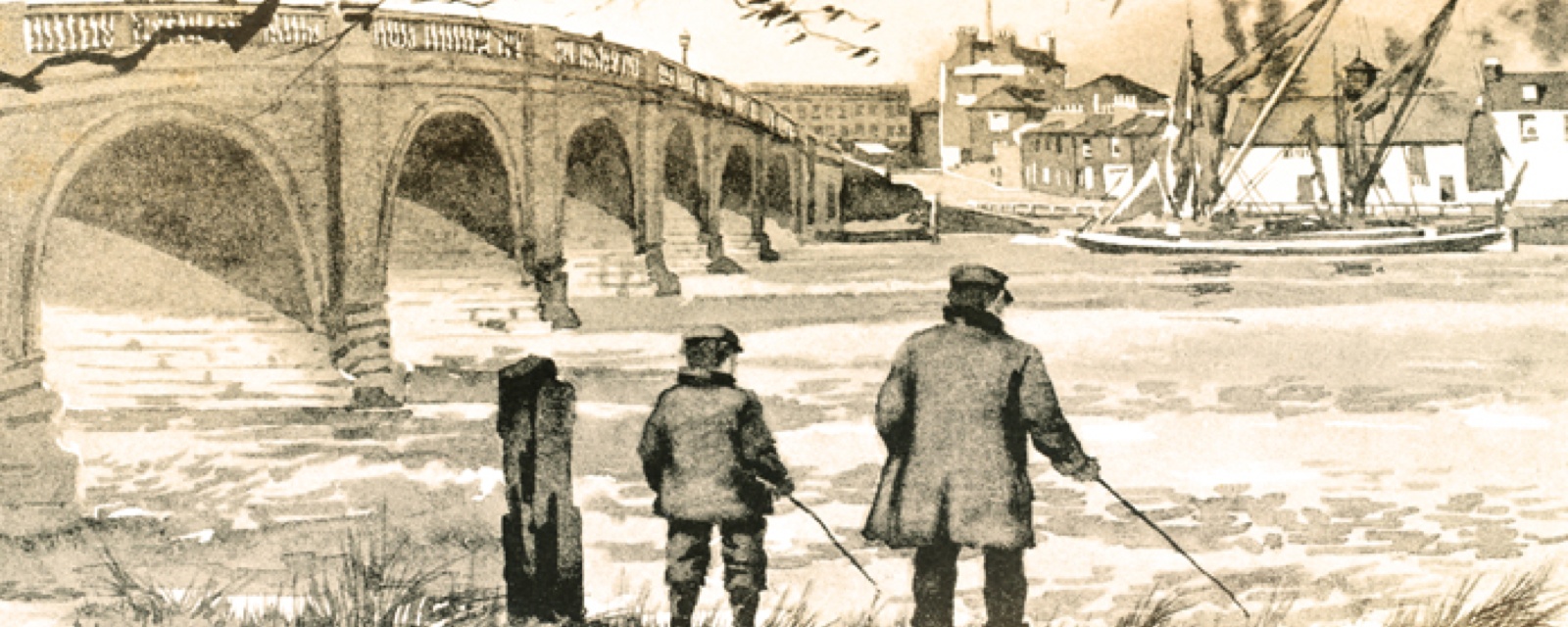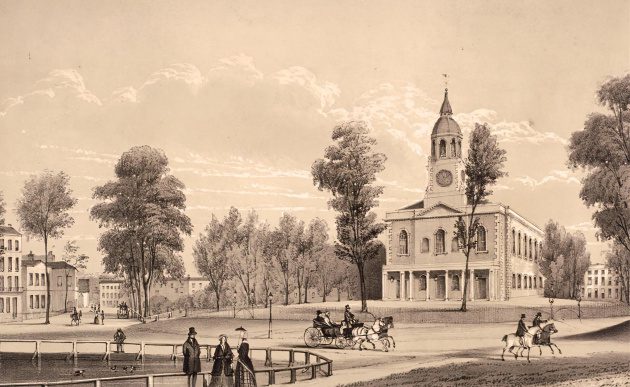The first and second bridges at Kew

The second Kew Bridge, that had opened in 1789. This view is facing north towards Brentford, with Strand on the Green on the opposite bank. It is from a painting by W. Luker Jr. and published by Leadenhall Press in ‘London City Suburbs’ in 1893, just six years before the bridge was demolished to make way for the current crossing.
Until the 18th century there was no dry crossing over the Thames between London Bridge and Kingston Bridge. Within the space of fifty years six new bridges were constructed, starting with Fulham Bridge in 1729 and Westminster in 1750. The third of those six bridges was at Kew.
For many centuries, possibly as far back as the Romans, a ferry crossed the Thames between Brentford and Kew, part of an important commercial link between London and the West Country. From 1659 it was managed by the Tunstall family. By the early 18th century two ferries were being operated by Robert Tunstall, a Brentford citizen of some consequence, one for pedestrians and the other for carriages. Traffic increased significantly from 1731 when, shortly after arriving in England, Frederick, Prince of Wales and his wife Augusta leased a house at Kew from the Capel family as their country home. William Kent was employed to enlarge and embellish it. From 1750 the couple began extensive works in the grounds, including a great pagoda. (In later times the estate became part of the Royal Botanical Gardens).
In 1757 Tunstall obtained an Act of Parliament to replace his ferry by a toll bridge from where the carriage ferry operated. (At that time the housekeeper at Kew Palace was a Mrs. Tunstall, so a family connection may have been significant in obtaining the Act). There were objections from barge-masters regarding his initial site on a bend, on the grounds that it would be difficult to navigate under. The bridge was finally located approximately a hundred metres downstream where the pedestrian ferry operated, requiring a second Act of Parliament. Work began in April of the following year. It consisted of two brick and stone arches at either bank, with seven wooden spans in the centre. Kew Bridge was built by John Barnard, a master-carpenter who had worked on Westminster Bridge. The completed work was dedicated to the Dowager Princess of Wales and her son George, the future King George III and they passed over the bridge even before its official opening three days later in June 1759. Upon its inauguration it was crossed by 3,000 people in the first day and a banquet was held for local gentry in the Rose & Crown at Kew, with a bonfire and illuminations on Kew Green. The Princess granted Tunstall £200, plus forty guineas to share among his workmen.
The following year Prince George was riding to London when he met a messenger crossing the bridge in the opposite direction who gave him the news that his father, George II, had died. Without emotion the prince declared that his horse was lame and turned back to Kew, forbidding his groom to say the contrary.
With the opening of the bridge, travellers could turn off the main London to Oxford road at Brentford and have a dry crossing through Kew, south-west to Richmond. Then still the only bridge between Fulham and Kingston, it proved to be very popular and Tunstall was able to charge a toll of one penny for pedestrians and one shilling and sixpence for a coach and six horses.
Robert Tunstall died shortly after the completion of the bridge and it was inherited by his son Christopher. The son suffered an early demise and ownership passed to his brother, also named Robert, who was then still a child.
The original Kew Bridge proved difficult for barges to navigate through and was regularly damaged. It was therefore unprofitable, despite its popularity, due to the high cost of maintenance. Less than 25 years after its opening, Robert commissioned James Paine, the designer of Richmond Bridge, which had opened in 1776, to construct a new stone crossing about 40 metres downstream. Work began in 1783 and the old bridge remained open for a further six years during the lengthy time it took to build the replacement. This handsome new crossing gently sloped over the river, consisting of seven arches and made of Portland and Purbeck stone, with a central arch of 65 feet in width. Paine’s wish was for it to be ornately decorated. That proved impossible on the rather small budget of £16,000, which had been raised by subscription, known as a tontine. Upon the death of each shareholder their shares reverted to the surviving shareholders. Thirty years after he had opened the original structure, King George III, together with Queen Charlotte, led a procession of carriages across the bridge at the opening ceremony in September 1789. A celebration dinner was held in the Star & Garter hotel on the north side of the bridge.
In 1824 an Act was passed for a new bridge at Hammersmith with lower tolls than Kew or Richmond. Concerned about the competition, Robert Turnstall sold Kew Bridge at auction to Thomas Robinson for £23,000. In 1848 Robinson built an adjacent landing stage for steamboat passengers.
An Act of Parliament was passed in 1869 to make all London bridges toll-free under the ownership of the Metropolitan Board of Works. Negotiations began for the MBW to purchase Kew Bridge and after five years a compromise was reached for it to change hands for £57,300. In February 1873 the Lord Mayor of London, City sheriffs, local dignitaries and the Chairman of the MBW formed a carriage procession from Gunnersbury station to the bridge, which was decorated with banners and triumphal arches at each end. The Mayor unlocked the tollgates with a specially made medieval key, canons were fired, and the bridge declared open. The tollgates were carried around Kew Green on a brewer’s dray and back to the Star & Garter at Brentford where a luncheon was held. In the evening there was a firework display.
Kew Bridge was later sold to the Surrey and Middlesex County Councils. Over a hundred years after its opening, they decided to replace the second bridge with the current version with a wider carriageway, which opened in May 1903.
Sources include: Peter Matthews ‘London Bridges’; Paul Lewis – The History of Kew Bridge (webpage); Ian Pay, Sampson Lloyd, Keith Waldegrave ‘London’s Bridges – Crossing the Royal River’; Sheila O’Connell ‘London 1753’; Susanne Groom, Lee Prosser ‘Kew Palace’; John Pudney ‘Crossing London’s River’.
<Go back to Bridges and Tunnels


